Seasonality & Harvest Methods

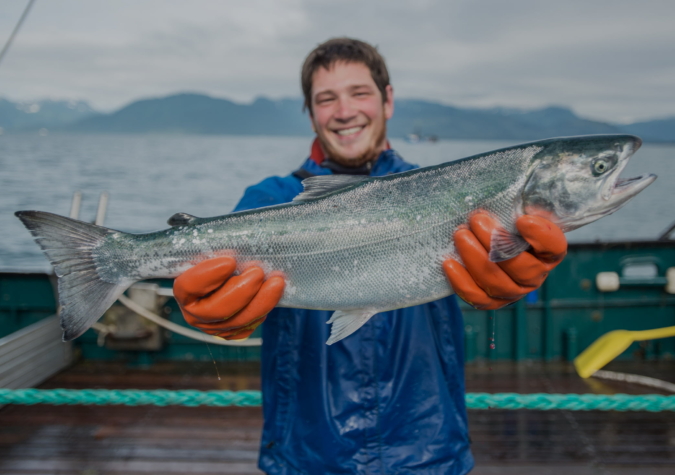
Seafood for All Seasons
Alaska’s harvesting areas support some of the most productive fisheries in the world.
Alaska seafood is harvested seasonally and available frozen, smoked and canned year round. Most Alaska seafood is flash frozen directly after harvest to maintain the highest quality, and maximize purity and taste.
Harvesting Alaska Salmon
Salmon Harvesting Season
Harvesters cooperate with researchers and managers to develop allocation and regulations methods for different gear types, fishing areas and fishing times to sustainably harvest salmon in Alaska.
- The five species of Alaska salmon are harvested primarily between May through September
- Wild Alaska king salmon makes the exception and is harvested nearly year-round
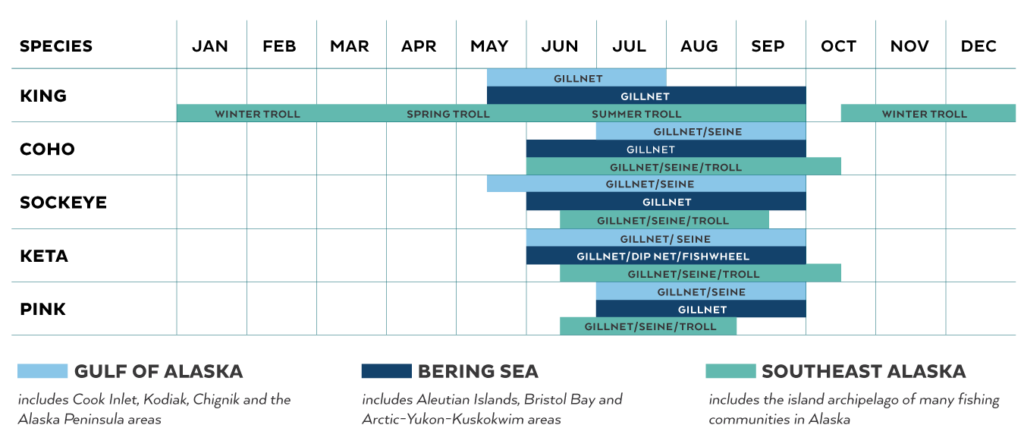
Exclusive Economic Zone
All fish harvested from Alaska are caught within the Exclusive Economic Zone, an area outlined by the United Nations Convention on the Law of the Sea:
- 3-200 nautical miles offshore (light blue shading) – the state has rights in regards to the exploration and the use of marine resources
- Up to 3 nautical miles offshore (orange outline) – Alaska’s salmon are harvested from areas relatively close to the coastline in this regional fishing area designated and managed by the state of Alaska
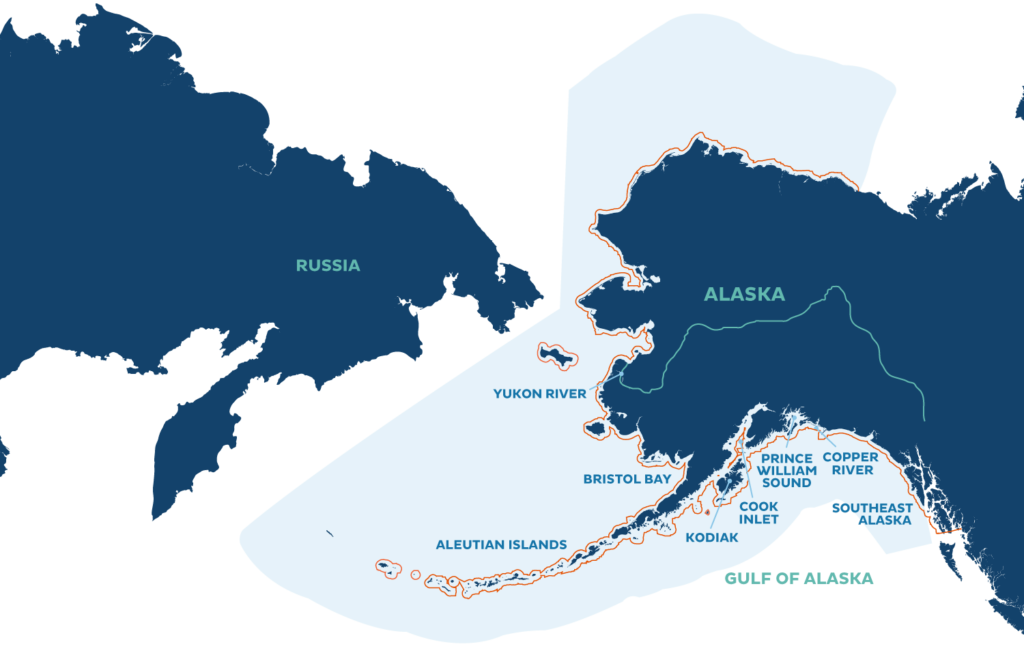
Salmon Harvesting Methods
All fishing gear used by Alaskan harvesters is specific to species behavior and fishery location.
- Salmon school tightly, not mixing very much with other species of fishes, so commercial salmon fishing has virtually no incidental catch of non-salmon species.
- The three types of commercial harvesting methods for salmon include gillnetting, purse-seining and trolling.
-
Gillnetting
-
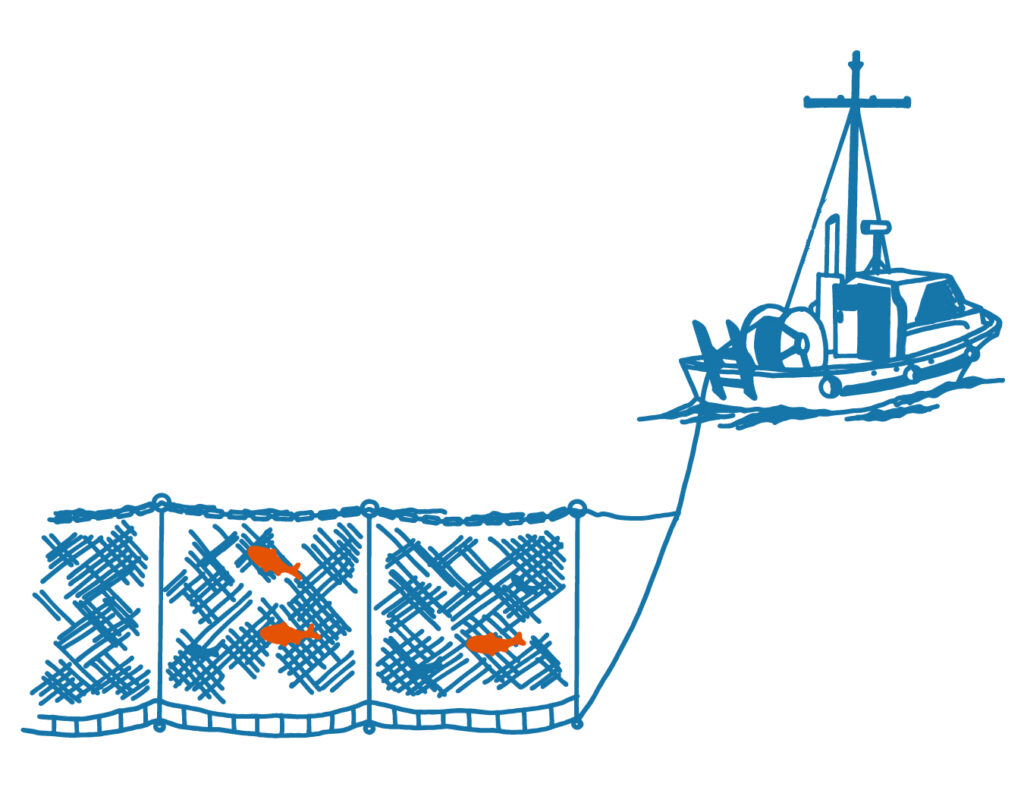
The greatest number of Alaska salmon are caught in gillnets of one type or another. Gillnetting involves laying a net wall in the water in the path of the fish and waiting for it to put its head into the mesh. When it does, the gills become entangled in the webbing and prevent the fish from escaping.
Most gillnetters are small one and two-man boats. State law dictates that gillnetters in Bristol Bay may be no longer than 32 feet. Most gillnetters outside of Bristol Bay are in the 32 to 42 foot range. A gillnet fisherman uses a net from 900 to 1800 feet long, a choice made by the State of Alaska for fisheries management reasons.
Some gillnetters are equipped to carry their fish in ice, or even in refrigerated holds, but the vast majority deliver their cargo daily. In areas like Bristol Bay, where fishing can be extremely heavy, a gillnetter may be forced to deliver every few hours simply because the small vessel will not hold the quantity of fish caught in a day. In such cases, the hold is usually divided into several bins, and each bin is lined with a cargo net. When the gillnetter comes alongside the tendering vessel, the cargo nets are simply lifted aboard, emptied and returned to the catcher vessel. The cargo-net system, relatively new in the fishery, reduces handling of the fish, and has contributed significantly to the quality of the catch.
-
Purse Seining
-
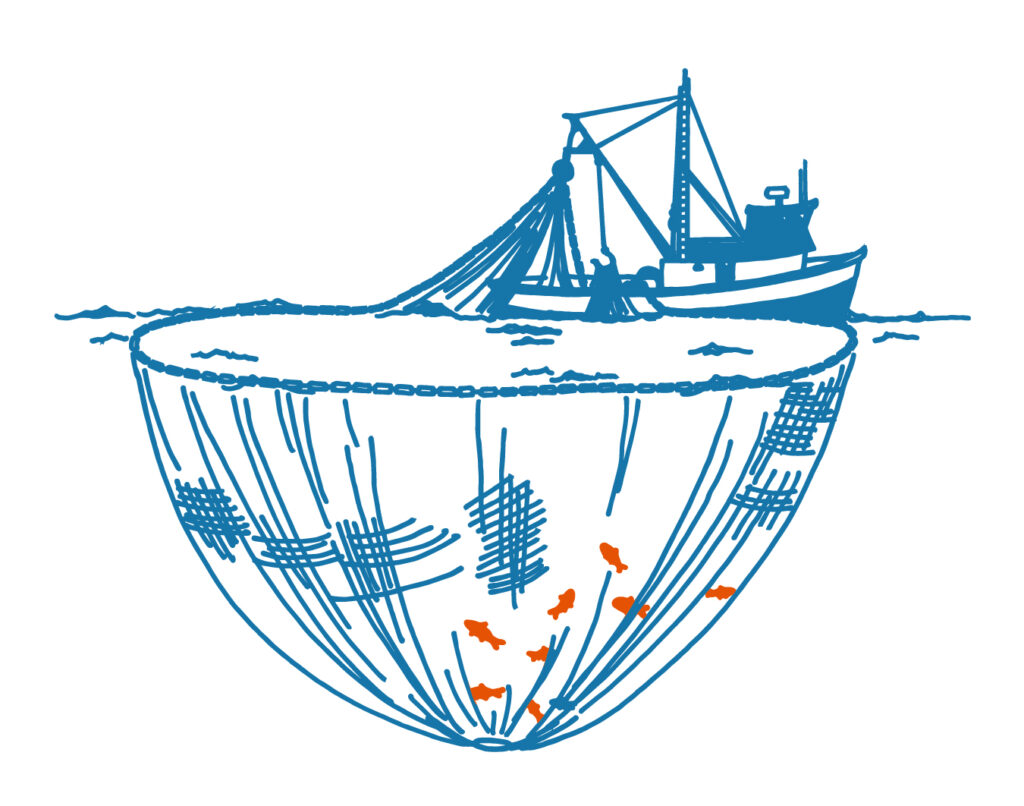
Large numbers of salmon are caught with seines in southeastern Alaska, central Alaska and western Alaska up to the tip of the Alaska Peninsula. No purse seining is allowed east of the Alaska Peninsula on the north side. Purse seiners are generally larger than gillnetters, but by Alaska law may be no longer than 58 feet. Those fishing in southeast Alaska are larger vessels capable of operating in the sometimes stormy fjords and channels found in that part of the state.
A purse seine is a net which is set in a circle and can be drawn closed at the bottom. Because salmon migrate in tight schools, it is not unusual for an Alaskan seiner to “wrap up” 250 to 1500 fish or more with one set. In addition, the salmon’s tendency to jump and “fin” on the surface gives away the school’s location as it moves through the water. When not actually engaged in setting or retrieving the net, every person on a purse seiner is watching the water for a sign of fish.
-
Trolling
-
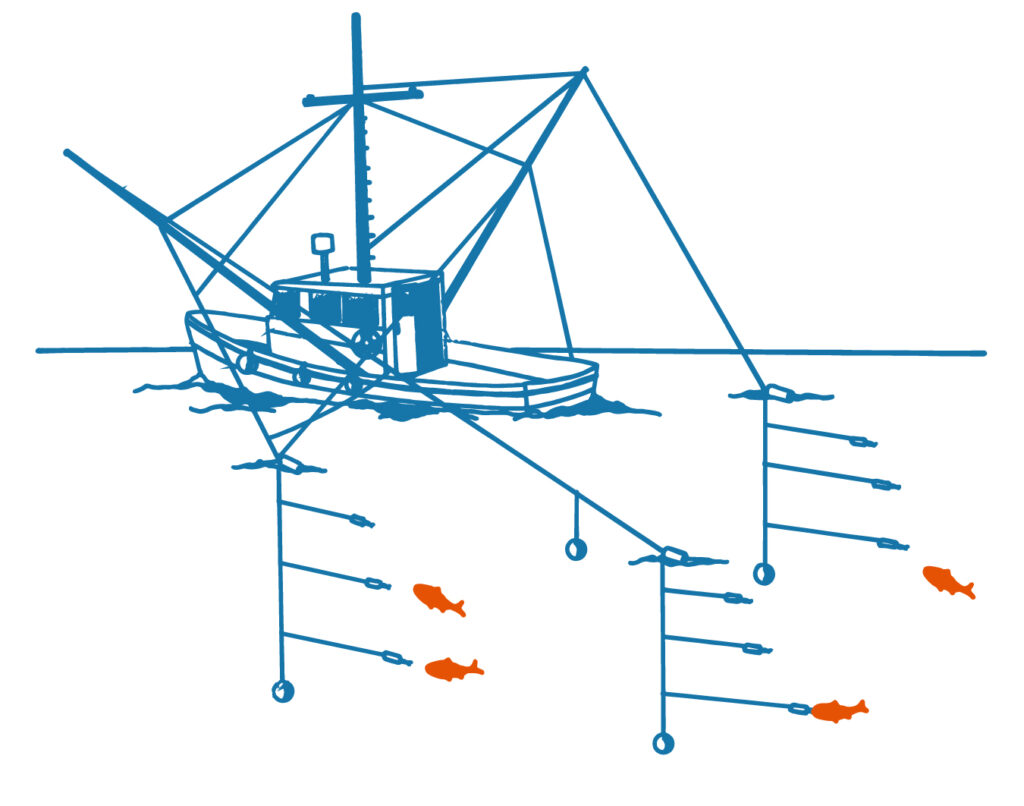
In southeast Alaska the first commercial fishermen to encounter salmon are members of the troll fleet. Trollers are small fishing vessels operated by one or two people who fish with a number of lines and hooks baited with herring or artificial lures. Of all the commercial salmon fishing methods, trolling may be the least efficient from the standpoint of intercepting fish. High seas trollers must search for fish in the open ocean; net fishermen, by contrast, wait in areas where salmon are known to school in the migratory route.
By way of compensation, trollers are allowed to fish beyond the inshore limits set for net fishermen, and generally have more days of fishing time. Modern fishery management tends to favor inshore methods and it is unlikely troll fishing will be significantly expanded.
Troll-caught fish are usually “ocean caught” or “brights”, that is, they are caught before maturity when they are moving inshore and feeding heavily. They are attractive fish, somewhat smaller, perhaps, than those caught by the net fisheries, but in full vigor of their ocean period. Only coho, king and pink salmon are taken in any number by the troll fleet and all three species, when delivered by a competent fisherman, command a premium price.
The volume of troll-caught fish is much smaller than that for net-caught fish. Troll-caught salmon generally make up less than 10 percent of the total Alaska catch of all species of salmon.What they lack in quantity, troll-caught salmon make up in quality. No fish is treated with more care from the time it leaves the water until it is delivered to the retailer’s door. A sharp rap on the head quiets the fish before the hook is removed; a thrashing fish is apt to bruise himself or dislodge scales.
The fish is then gilled and gutted. Ice will be carefully packed in the body and head cavity and the fish will be laid on a layer of ice in such a way that the body cavities can drain freely. The surrounding ice will be arranged so that no fish comes in contact with another fish and so that all liquids drain away from the fish and into the vessel’s bilge where it is pumped overboard. If the vessel has freezing capability, the fish will be blast-frozen much the way it is ashore, dipped in fresh water to form an ice glaze and placed carefully in the hold.
Almost all troll-caught fish go into the fresh, frozen or smoked market. The small number of fish represented in the troll catch, combined with their uniform attractiveness, make them the most valuable, pound for pound, of the Alaska salmon.
Harvesting Alaska Shellfish
Shellfish Harvesting Season
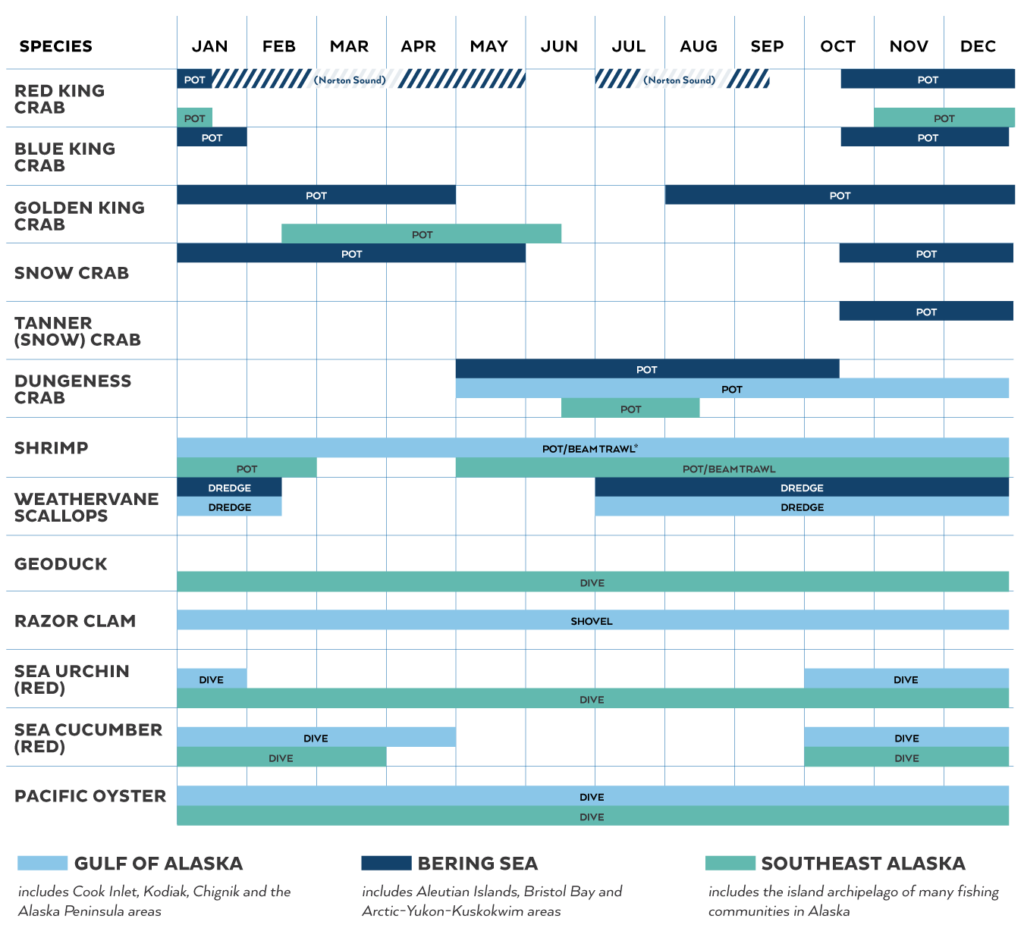
Exclusive Economic Zone
All fish harvested from Alaska are caught within the Exclusive Economic Zone, an area outlined by the United Nations Convention on the Law of the Sea:
- 3-200 nautical miles offshore (light blue shading) – the state has rights in regards to the exploration and the use of marine resources
- Up to 3 nautical miles offshore (orange outline) – Alaska’s salmon are harvested from areas relatively close to the coastline in this regional fishing area designated and managed by the state of Alaska

Shellfish Harvesting Methods
Alaska shellfish harvesters are dedicated to responsible catch methods and have participated in scientific studies to avoid incidental catch of non-target species.
- Harvesters cooperate with researchers to develop modified gear and harvesting techniques that reduce bycatch, improve quality and preserve the marine habitat.
- Types of commercial harvesting for shellfish include pot fishing, diving, dredging, and shoveling/raking.
-
Geoducks, Sea Cucumbers & Sea Urchins
-
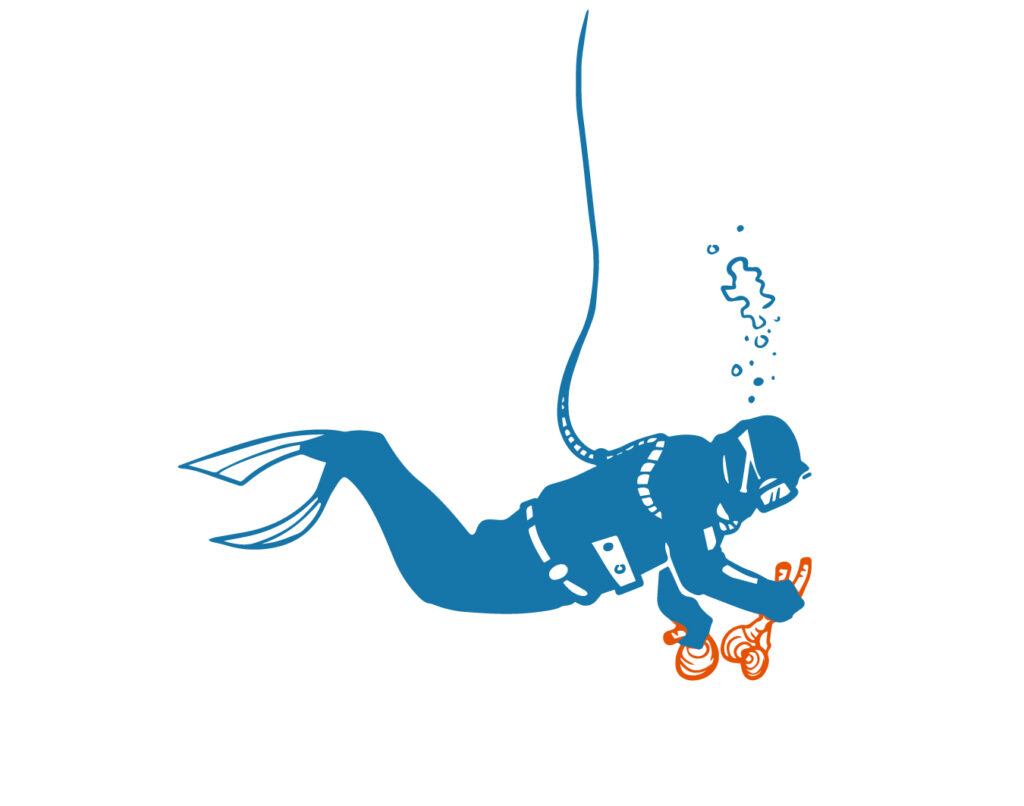
Alaska’s icy waters are the source of many different dive products. Geoducks, sea urchins and sea cucumbers are generally harvested in the cold clean waters of southeast Alaska. Individual harvesters using hookah, surface supplied air, or scuba gear gather these products. The Alaska Department of Fish and Game employs responsible management techniques in order to ensure the sustainability of these fisheries.
Geoducks are a large bivalve with a wonderful texture and delicate, clean flavor, reminiscent of the ocean. They are served in sushi restaurants and can be used as a substitute for conch. Geoducks are served as sashimi, ceviche, and fritters. These large clams are harvested in the fall; the season can run from October to May.
Sea cucumbers are an echinoderm; the season starts the first week of October and typically runs through December. Sea cucumbers are used for a variety of things, both medicinal and cuisine. Sea cucumbers have five strips of white meat, with a calamari-like flavor and texture. Great in a variety of recipes, from stir-fries to hot pots.
Sea urchins are harvested year-round, mostly around Craig and Ketchikan. Red sea urchins are beautiful; the roe (uni) is golden and sweet. Sea urchin roe is shipped, jugged, trayed or live. Sea urchin roe is served at sushi restaurants, in soufflés and patés.
-
Alaska Crab
-
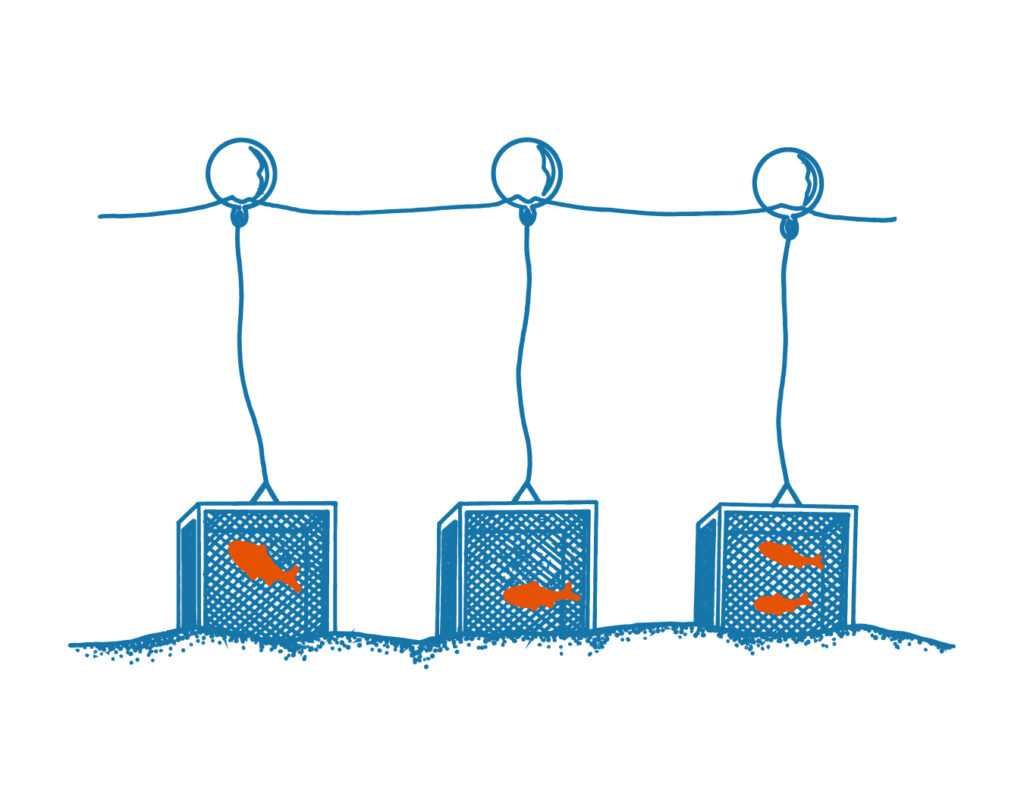
Crabbing, the method of harvesting Dungeness, king, and snow crab, is difficult and grueling work. Steel traps or pots are baited with cut fish, then pushed over the side.
Buoys mark the location of each pot, and its owner. At the right time, judged by gut instinct and years of experience, the pots are hauled in, quickly emptied into the hold, rebaited, and returned to the ocean floor.
-
Alaska Clams
-
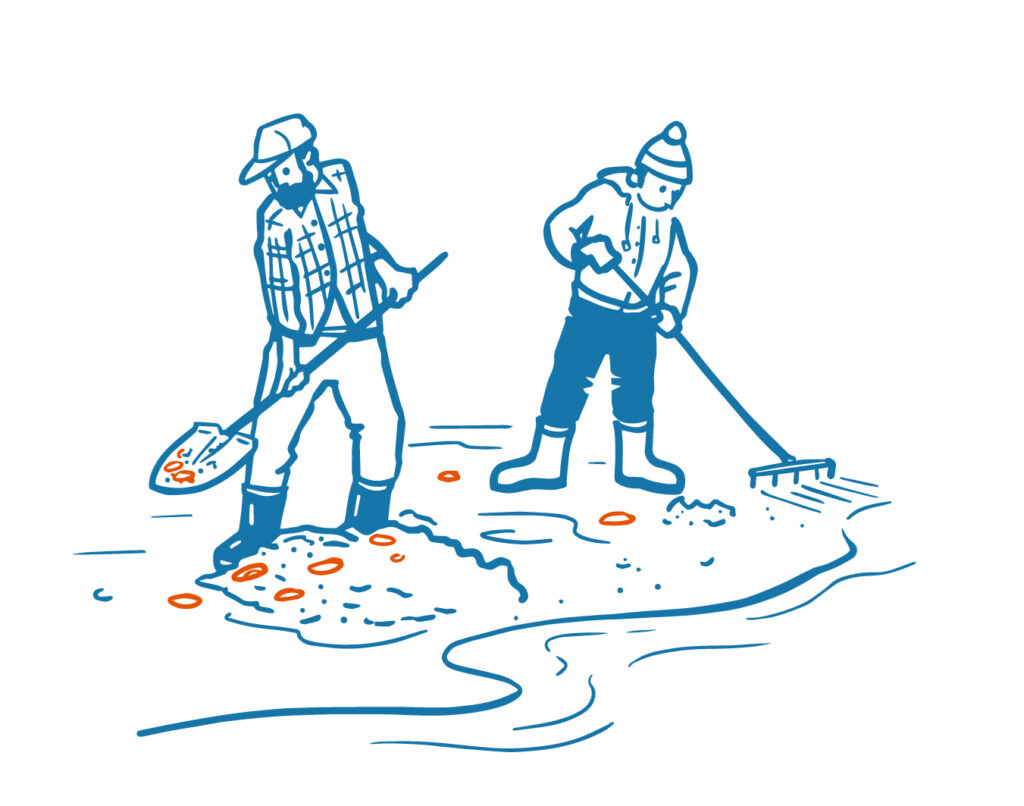
Hard shell clams, principally littleneck clams and razor clams are harvested in the cold waters of the Cook Inlet region. Littleneck and other hard shell clams (cockles and butter clams) are dug by hand shovel in the Kachemak Bay area. A commissioner’s permit is required. Razor clams are dug with shovels and clam “guns.”
Current and historical harvest areas are sandy beaches of lower Cook Inlet, the Alaska Peninsula, and near Cordova.
-
Alaska Weathervane Scallops
-
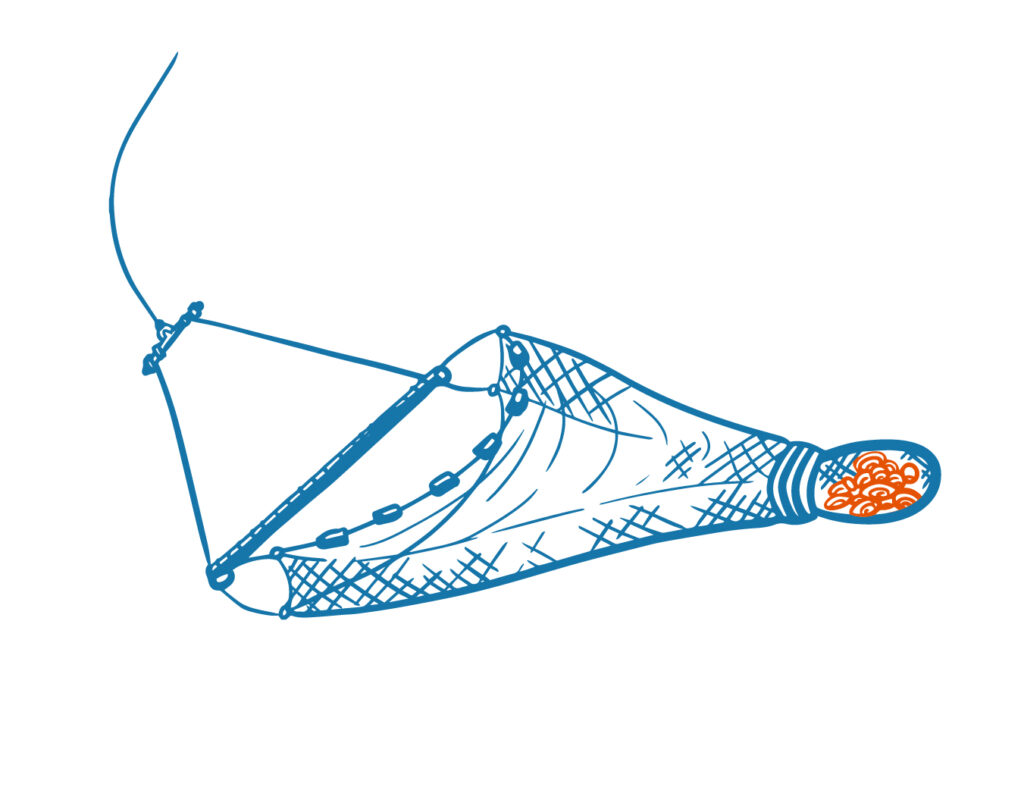
Harvested in the icy waters off the Gulf of Alaska, Alaska scallops are harvested via standard New Bedford-style dredges that consist of a 12 to 15-foot wide fixed frame to which a steel ring bag, consisting of 4-inch rings linked together, is attached to collect the scallops as the dredge is towed. Alaska Scallops are hand-shucked and frozen within hours, ensuring their just-caught flavor and texture.
Packed on board without the use of chemicals or preservatives, Alaska Scallop fishermen are able to consistently deliver products which live up to their reputation for flavor and freshness, and because the Alaska Scallop fishery is conservatively managed and tightly regulated, a consistent supply of high-quality seafood is assured, year-round.
-
Alaska Shrimp
-

Harvested in the icy waters from the Aleutian Islands to Southeast Alaska, Alaska shrimp are known for their tender texture and distinctive flavor. Pink shrimp are the primary species by weight, and these are targeted with bottom trawls and beam trawls. Most of the catch of northern shrimp is shelled by mechanical peelers and then frozen.
Spot shrimp are the largest and most valued of the Alaskan shrimp and are marketed as live, fresh, or frozen products. These are targeted with pots in generally steep and rough bottom terrain. Other shrimp harvested include sidestripe shrimp with trawls, coonstripe shrimp targeted with pots, and humpy shrimp mostly caught incidentally in trawls.
Harvesting Alaska Whitefish
Whitefish Harvesting Season
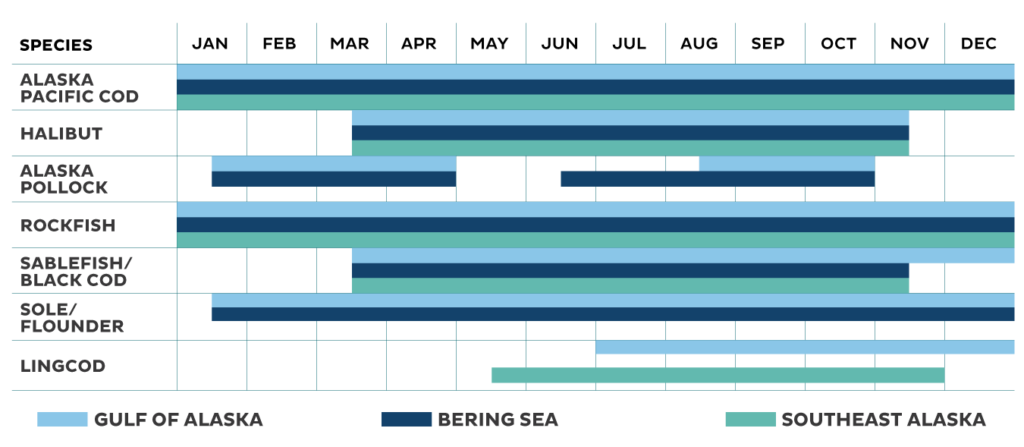
FAO 67
Most of Alaska’s whitefish species are harvested from the Bering Sea and the Gulf of Alaska located in the United Nations’ Food & Agriculture Organization (FAO) statistical catch area 67. This area supports some of the most productive fisheries in the world.
- FAO 67 (orange dot outline) – the world’s boundaries of the major fishing areas established for statistical purposes.
- Exclusive Economic Zone (light blue shading) – The Alaska Exclusive Economic Zone extends 200 nautical miles off the coastline. Within this zone, the U.S. has sovereign rights to the management of the resources.
- Continental Shelf (teal shading) – the extension of Alaska’s coast consisting of relatively shallow, productive waters. Alaska’s continental shelf comprises 70% of the nation’s total.
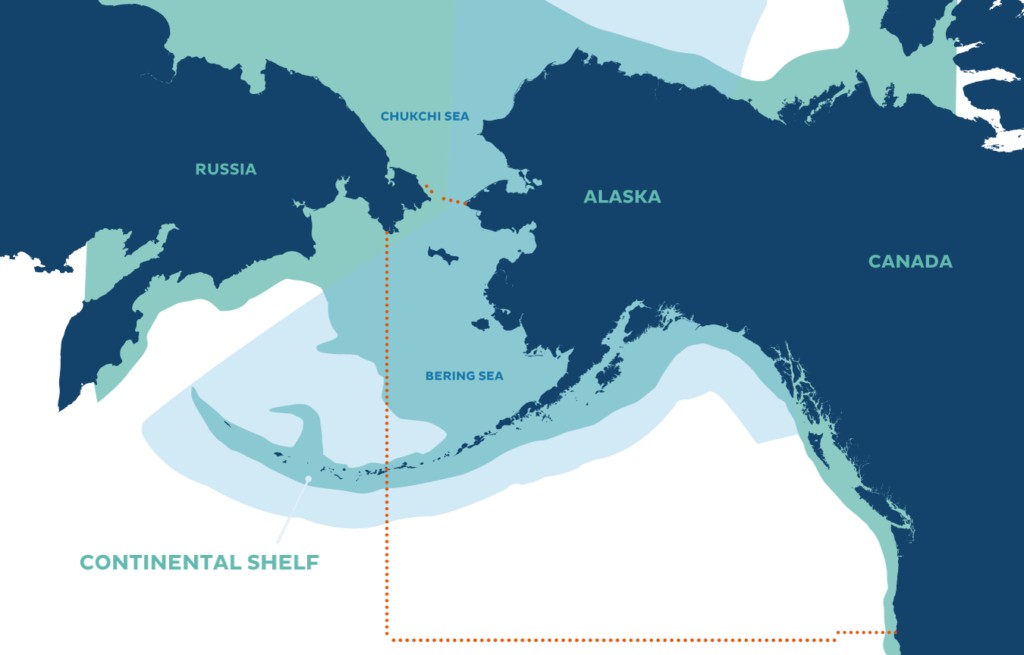
Whitefish Harvesting Methods
Alaska whitefish fishermen are dedicated to responsible catch methods, and have participated in scientific studies to avoid incidental catch of non-target species.
- Fishermen cooperate with researchers to develop modified gear that promotes bycatch reduction, improved quality and preservation of marine habitat.
- Types of commercial harvesting methods for whitefish species include pot fishing, longlining, jig fishing and varying types of trawling.
-
Longline
-
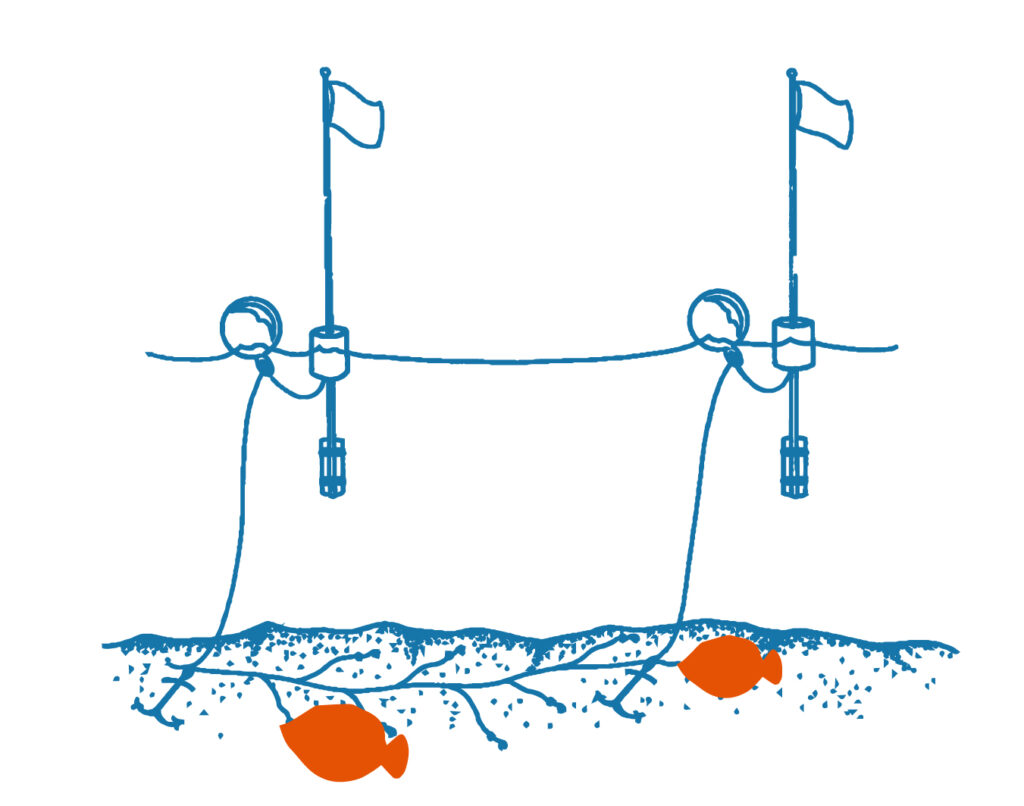
The only legal fishing method for halibut is longline gear. Longline fishing is also often used for harvesting black cod and Pacific cod, but never for pollock or sole. Longline fishing vessels are usually independently run by owner-operators. Some longliners are small boats, less than 50 feet in length, but most are somewhat larger.
Longline gear is composed of groundline, buoy lines, and gangions, which are short pieces of line with hooks on the end. Longlines are set along the seabed, with baited hooks every few yards. Longline hooks are retrieved one at a time. The fishermen can unhook other species of fish and return them alive to the sea without bringing them on board. In this way, longlining is considered a style of fishing with very little bycatch. There are also strict rules in place to prevent seabirds from being accidentally caught in longline gear.
-
Pots
-

Pots are used only for black cod, Pacific cod, and crab.
Pots are large steel-framed cages covered in net mesh. The baited pots are placed on the seafloor where they trap the fish or crab. Fish or crab enter the traps through tunnels but cannot escape. Later the pots are retrieved and the seafood are sorted on deck. Non-target species are returned alive to the sea.
In contrast to years past, very little fishing gear is lost at sea. The old problem of “ghost gear” (lost gear that continues to fish) has essentially disappeared. Because of improvements in cables, net materials, and fishing methods, the loss of a trawl is a very rare event. Pots must have biodegradable panels which allow fish to escape in the event that a pot is lost. Important changes in fishery management regulations allow longliners to fish at a slower and safer pace, so they can avoid setting more gear than they can recover.
-
Trawl
-

A trawl is a large, bag-shaped net that is towed by a fishing vessel. Trawlers (not to be confused with trollers) are generally large boats ranging from 70 feet to over 200 feet in length. The doors, because of the way they are built and rigged to the trawl, keep the mouth of the trawl open as it moves through the water. The headrope is equipped with floats forming the upper opening. The footrope is rigged with weights forming the lower opening. Trawlers use sophisticated ultrasonic devices both for location of fish underwater and for species identification.
Two types of trawl gear are used in Alaska. Pollock are caught using mid-water, or pelagic, trawls, which are designed to fish off the ocean bottom to avoid damage to the benthic habitat. Fishing with mid-water trawls is a selective method of fishing, because the nets can be operated in ways to minimize the incidental catch of non-target species. Pollock are usually harvested with few other species. Sole are generally captured in bottom trawls along with other bottom-dwelling species, which are sorted onboard the fishing vessel. Bottom trawling is allowed only in certain areas and strict limits are enforced upon the amount of non-target species (such as crab or halibut) that may be caught.
-
Jig
-
Jig fishing is a hook-and-line fishing method that utilizes artificial lures and an electric machine to jerk (jig) the line up and down. Each machine may have up to five lines and each line may have up to 30 hooks attached. Jig fishing vessels are comparable in size to smaller pot and longline vessels. Fish caught are selectively sorted and non-targeted fish are returned live to the ocean.
